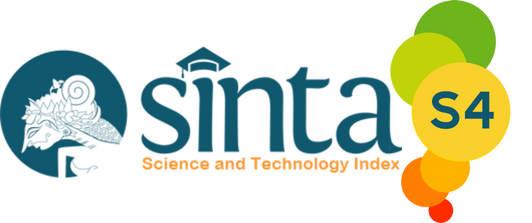Analisis Multi Peran Ibu Rumah Tangga di Desa Slogoretno Kecamatan Jatipurno Kabupaten Wonogiri
Abstract
Housewives who participate as workers will experience multiple roles in their lives. The involvement of women in the workforce has the consequence of limiting time in work and family life. Understanding the balance of roles is essential because it can give rise to positive and negative impacts from these multiple roles. This research aims to describe and analyze the roles of housewives and gender relations in the family. This research method is descriptive qualitative with a case study approach. The process for determining informants was carried out purposively with the criteria of coming from a complete farming family (husband and wife) and the wife taking part in instant herbal medicine processing so that 22 informants consisting of the Slogoretno Village Head (1 person), a housewife and her husband (10 pairs), chairman of the family welfare empowerment (PKK) of Slogoretno Village (1 person). Data collection techniques include in-depth interviews, observation, and documentation, employing Miles and Huberman’s interactive analysis and Harvard gender analysis methodologies. Data validity uses triangulation of sources and methods. The results obtained in this research are that the multi-role forms carried out by housewives, especially in farming families, are divided into 7 roles, namely the roles of mother, wife, worker, relative, and roles in domestic, community, and individual activities. The gender dynamics established often involve patterns of cooperation in role division and decision-making, affecting access, control, and benefits related to resources. In Slogoretno Village, the division of roles within farming families reveals that wives and husbands primarily handle reproductive tasks, while productive and social roles are typically shared.
Keywords
Full Text:
PDFReferences
Abdillah, A. S., & Puspaningrum, D. (2021). Peran wanita dan relasi gender dalam keluarga buruh tani wanita di Regu Tanam Mulyo Asri Desa Pontang Kecamatan Ambulu Kabupaten Jember. Jurnal Kirana, 2(1), 42–53. https://doi.org/https://jurnal.unej.ac.id/index.php/jkrn/article/view/24059
BPS. (2023a). Indeks ketimpangan gender (IKG) tahun 2023. Tersedia dari https://www.bps.go.id/id/pressrelease/2024/05/06/2387/indeks-ketimpangan-gender--ikg--indonesia-mengalami-penurunan-yang-signifikan-menjadi-0-447--menunjukkan-perbaikan-yang-stabil-dalam-kesetaraan-gender.html
BPS. (2023b). Tingkat partisipasi angkatan kerja Provinsi Jawa Tengah tahun 2023. Tersedia dari https://jateng.bps.go.id/indicator/6/63/1/tingkat-partisipasi-angkatan-kerja-tpak-.html
Cerrato, J., & Cifre, E. (2018). Gender inequality in household chores and work-family conflict. Frontiers in Psychology, 9, 384557. https://doi.org/10.3389/fpsyg.2018.01330
Choiryah, R., Ratrie, A., Putri, S., & Prasetyo, B. (2020). Women as traders: Study on the triple roles and gender inequality in Gresik. Lectio Socialis, 4(1), 1–13. https://dergipark.org.tr/en/pub/lectio/issue/52072/559866
Firmansyah, F., & Rahma, K. A. (2022). Analisis multi-peran kepala sekolah dalam meningkatkan kompetensi pedagogik guru. Jurnal Konsepsi, 11(3), 426–446. Tersedia dari https://p3i.my.id/index.php/konsepsi/article/view/235
Karniawati, N. (2013). Kinerja dosen perempuan: Studi relasi gender di Unikom. Jurnal Ilmu Politik dan Komunikasi UNIKOM, 1, 1–16. Tersedia dari https://repository.unikom.ac.id/30655/
Lal, R., & Khurana, A. (2011). Gender issues: The role of women in agriculture sector. ZENITH International Journal of Business Economics & Management Research, 1(1), 29–39. Tersedia dari http://www.agritech.tnau.ac.in/women_in_agri/pdf/women_emp/introduction.pdf
Lubis, M. S. A., & Harahap, H. S. (2021). Peranan ibu sebagai sekolah pertama bagi anak. Jurnal Ilmu Pendidikan, 2(1), 6–13. https://doi.org/10.32696/jip.v2i1.772
March, C., Smyth, I., & Mukhopadhyay, M. (1999). A guide to gender-analysis frameworks. Oxfam GB.
Miles, M. B., & Huberman, A. M. S. J. (2014). Qualitative data analysis (A Methods Sourcebook (H. Salmon, K. Perry, K. Koscielak, & L. Barrett (eds.); 3rd ed.). SAGE Publications, Inc.
Nurmayasari, D., & Ilyas, I. (2014). Peran anggota kelompok wanita tani (KWT) Laras Asri pada peningkatan kesejahteraan keluarga (Studi deskriptif di Dusun Daleman Desa Kadirejo Kecamatan Pabelan Kabupaten Semarang). Journal of Nonformal Education and Community Empowerment, 3(2), 16–21. https://doi.org/10.15294/jnece.v3i2.3728
Oppong, C. (1980). A synopsis of seven roles and status of women an outline of a conceptual and methodological approach. Tersedia dari https://scholar.google.co.id/scholar?cites=7452687174877086919&as_sdt=2005&sciodt=0,5&hl=id
Pryzgoda, J., & Chrisler, J. C. (2000). Definitions of gender and sex: The subtleties of meaning. Sex Roles, 43, 553–569. https://doi.org/10.1023/A:1007123617636
Putri, D. P. K., & Lestari, S. (2015). Pembagian peran dalam rumah tangga pada pasangan suami istri Jawa. Jurnal Penelitian Humaniora, 16(1), 72–85. https://doi.org/10.23917/humaniora.v16i1.1523
Sadilla, P. S., & Yulianingsih, Y. (2022). Multi peran perempuan: Studi kasus pada pedagang di Tengger. Umbara, 7(2), 113–120. Tersedia dari https://jurnal.unpad.ac.id/umbara/article/view/35535
Sitanggang, M. N. (2018). Peran perempuan dalam keluarga petani pegunungan Tengger. Jurnal Umbara, 3(1), 1–13. Tersedia dari https://jurnal.unpad.ac.id/umbara/article/view/25576
Telaumbanua, M. M., & Nugraheni, M. (2018). Peran ibu rumah tangga dalam meningkatkan kesejahteraan keluarga. Sosio Informa: Kajian Permasalahan Sosialdan Usaha Kesejahteraan Sosial, 4(2), 418–436. https://ejournal.kemensos.go.id/index.php/Sosioinforma/article/view/1474
Wahaga, E. (2018). The gendered nature of productive and reproductive roles in the agricultural sector. International Journal of Development and Sustainability, 7(1), 120–146. Tersedia dari https://csirspace.foodresearchgh.org/handle/123456789/1329
Refbacks
- There are currently no refbacks.






